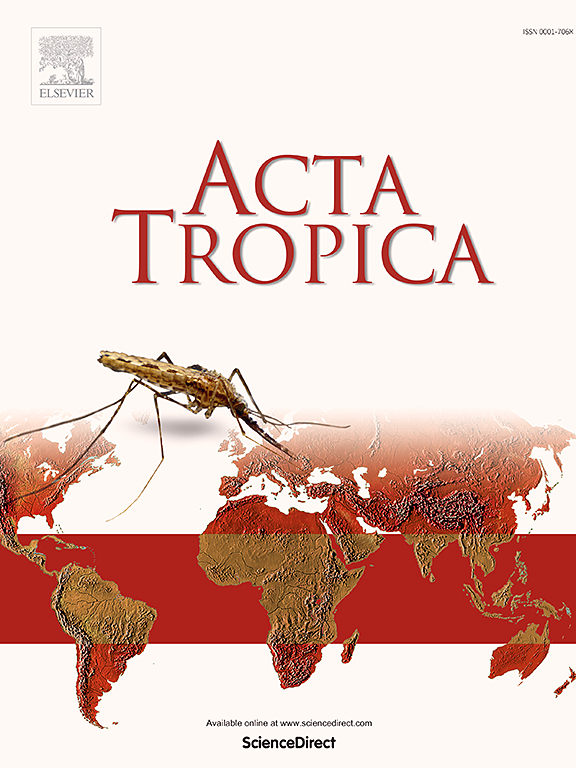Trichinella spiralis excretory-secretory protein alleviates autoimmune thyroiditis by modulating Th17/Treg balance via the STAT3/STAT5 pathway
IF 2.1
3区 医学
Q2 PARASITOLOGY
引用次数: 0
Abstract
Hashimoto’s thyroiditis (HT) is an organ-specific autoimmune disease mediated by T cells. Patients with HT are generally treated with lifelong thyroid hormone therapy. Trichinella spiralis is recognized as a "master" of immunomodulation, but the immunomodulatory effect of its excretory-secretory (ES) proteins on HT remains unclear. This study established an experimental autoimmune thyroiditis (EAT) mouse model to analyze the effects of T. spiralis muscle larvae (ML) ES protein intervention on thyroid pathological changes, immune cell balance and cytokine levels. The results demonstrated that ML ES protein significantly alleviated thyroid follicular destruction and inflammatory cell infiltration in EAT mice, reducing thyroid hormone and thyroid autoantibody levels. Flow cytometry analysis revealed that ES protein intervention decreased the proportion of Th17 cells, and increased the proportion of Treg cells in EAT mice. The qPCR results indicated that ES protein down-regulated mRNA expression of IL-17A and RORγt while up-regulating IL-10 and Foxp3 in EAT mouse spleen and thyroid tissues. Serum ELISA detection showed a decrease in IL-17A, CCR6 and CCL20, and an increase in IL-10 in mice. In addition, ES protein significantly inhibited the expression of NLRP3 protein in thyroid tissue, modulated the STAT3/STAT5 signaling pathway, decreased STAT3 phosphorylation and increased STAT5 phosphorylation. rIL-17A administration reversed ES protein protective effects, exacerbating thyroid damage. In conclusion, T. spiralis ML ES protein regulates the Th17/Treg cell balance through the STAT3/STAT5 signaling pathway, inhibits the excessive IL-17A secretion and NLRP3 inflammasome activation, and mitigates thyroid inflammation in EAT mice. This research revealed that T. spiralis ML ES protein could be a potential candidate immunomodulation molecule and provides new experimental evidence for the treatment of HT.

旋毛虫排泄分泌蛋白通过STAT3/STAT5通路调节Th17/Treg平衡,减轻自身免疫性甲状腺炎
桥本甲状腺炎是一种由T细胞介导的器官特异性自身免疫性疾病。HT患者通常接受终身甲状腺激素治疗。旋毛虫是公认的免疫调节“大师”,但其排泄-分泌(ES)蛋白对HT的免疫调节作用尚不清楚。本研究建立实验性自身免疫性甲状腺炎(EAT)小鼠模型,分析螺旋螺旋体肌幼体(ML) ES蛋白干预对甲状腺病理改变、免疫细胞平衡及细胞因子水平的影响。结果表明,ML ES蛋白可显著减轻EAT小鼠甲状腺滤泡破坏和炎症细胞浸润,降低甲状腺激素和甲状腺自身抗体水平。流式细胞术分析显示,ES蛋白干预降低了进食小鼠Th17细胞比例,增加了Treg细胞比例。qPCR结果显示,ES蛋白下调了进食小鼠脾脏和甲状腺组织中IL-17A和RORγt mRNA的表达,上调了IL-10和Foxp3 mRNA的表达。血清ELISA检测显示小鼠IL-17A、CCR6、CCL20降低,IL-10升高。此外,ES蛋白显著抑制NLRP3蛋白在甲状腺组织中的表达,调节STAT3/STAT5信号通路,降低STAT3磷酸化,增加STAT5磷酸化。il - 17a可逆转ES蛋白的保护作用,加重甲状腺损伤。综上所述,螺旋螺旋体ML ES蛋白通过STAT3/STAT5信号通路调节Th17/Treg细胞平衡,抑制IL-17A过量分泌和NLRP3炎性体激活,减轻EAT小鼠甲状腺炎症。本研究揭示螺旋螺旋体ML ES蛋白可能是一种潜在的候选免疫调节分子,为治疗HT提供了新的实验依据。
本文章由计算机程序翻译,如有差异,请以英文原文为准。
求助全文
约1分钟内获得全文
求助全文
来源期刊

Acta tropica
医学-寄生虫学
CiteScore
5.40
自引率
11.10%
发文量
383
审稿时长
37 days
期刊介绍:
Acta Tropica, is an international journal on infectious diseases that covers public health sciences and biomedical research with particular emphasis on topics relevant to human and animal health in the tropics and the subtropics.
 求助内容:
求助内容: 应助结果提醒方式:
应助结果提醒方式:


